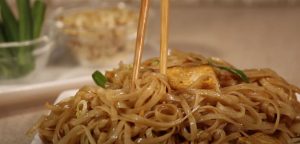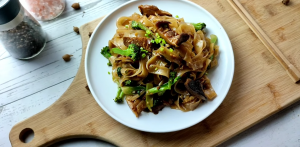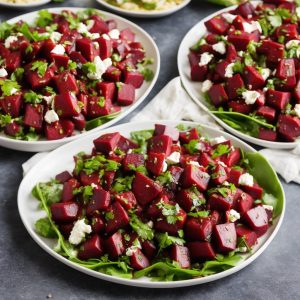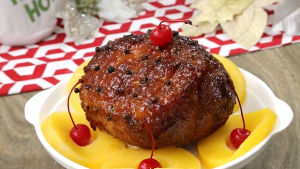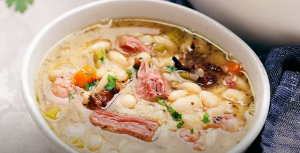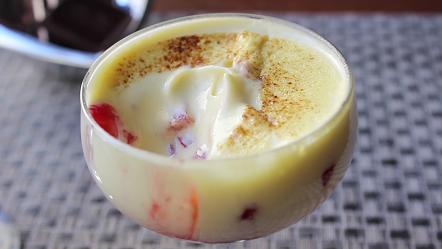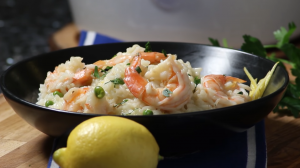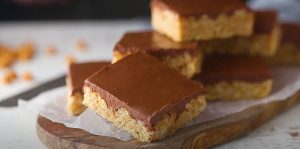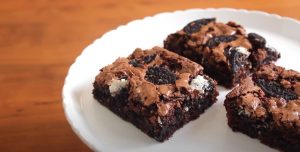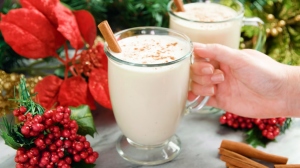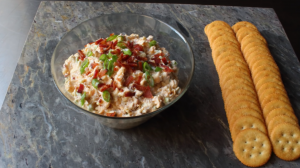Pad Thai is a classic street dish from Thailand, loaded with vibrant flavors. This recipe covers a foolproof way to recreate this Asian favorite right in your kitchen. The sweet, sour, and salty blend of the sauce pairs perfectly with chewy rice noodles, succulent shrimp, and a crunchy topping of peanuts. This dish requires some preparation, but the result is a colorful, tasty, and satisfying meal.
The ingredients used in Pad Thai are specific to Asian cuisine. Fish sauce is a staple in Thai cooking, made from fermented fish and salt; it adds a unique umami flavor. Tamarind paste, derived from tamarind fruit, gives the dish its characteristic tangy flavor. Rice noodles are thicker and chewier than regular pasta, key for absorbing the delicious sauce. Lastly, you'll need roasted unsalted peanuts for adding the perfect crunch to your Pad Thai. These ingredients are typically found in the international aisle in most supermarkets or local Asian grocery stores.
Classic Pad Thai Key Ingredients
Rice noodles: These are flat, wide noodles that add a chewy texture to the dish. They are excellent at soaking up the flavors of the sauce.
Fish sauce: A salty, fermented condiment common in Southeast Asian cooking. It gives the dish a deep umami flavor.
Rice vinegar: This is a mild, slightly sweet vinegar that adds a necessary tang to balance the flavors in the dish.
Tamarind paste: A sour, fruity ingredient that adds depth and complexity to the dish.
Granulated sugar: Used to balance the sourness from the tamarind and the saltiness from the fish sauce.
Canola oil: Used for frying and sautéing, it has a neutral flavor that doesn't overshadow the other ingredients.
Eggs: They add protein to the dish and give it a rich, creamy texture.
Shrimp: Adds a sweet, seafood flavor that pairs excellently with the tangy sauce.
Roasted unsalted peanuts: Used for topping, they add a crunchy texture and a nutty flavor.
Bean sprouts: They add a delightful crunch and a refreshing, slightly sweet flavor.
Lime: Used as garnish, it adds a refreshing citrus kick when squeezed over the finished dish.
Cilantro: A herb garnish that adds a fresh, citrusy flavor.
Red pepper flakes: Add a spicy kick to the dish, use according to taste preference.
One reader, Edy Macon says:





This classic pad thai recipe is a game-changer! The flavors are perfectly balanced, and the dish is so satisfying. The step-by-step instructions made it easy to prepare, and the end result was absolutely delicious. I'll definitely be making this again and again!
Key Techniques for Mastering Pad Thai
How to prep the noodles: Soak the noodles in cold water for at least 2 hours or up to 12 hours. It can be refrigerated or not.
How to make the sauce: Whisk together the fish sauce, vinegar, tamarind concentrate, and sugar until smooth. Adjust the sauce as needed and add a pinch of paprika or cayenne powder for color.
How to cook the eggs: Crack the eggs into the pan and gently loosen and break the yolk. Cook for about 1 minute without scrambling.
How to cook the shrimp: Toss the shrimp in the pan for about 1 minute and move them around to get some color on them.
How to soften the noodles: Gently dip the noodles in and out of hot water to soften them but not cook them. Shake out the excess hot water and transfer them to the pan with the shrimp.
How to integrate the sauce with the noodles: Add the sauce to the pan and toss and flip the noodles to integrate the sauce. When there’s no more sauce in the pan, it's ready and the noodles have absorbed the sauce.
How to finish the dish: Add the peanuts and sprouts, toss all ingredients together quickly, and cook for 2 to 3 minutes until everything is heated through. Serve immediately in individual bowls with wedges of lime, additional peanuts, chopped cilantro, and/or chili flakes, if desired.
How To Make Pad Thai
Loaded with shrimp, tender noodles, and a tangy, savory sauce, this pad thai tastes as good as its resto version. Serve with nuts and chili for some heat.
Serves:
Ingredients
For Pad Thai:
- 14ozflat, wide rice noodles
- 8tbspfish sauce
- ¾cuprice vinegar
- 2tsptamarind paste,also sometimes called concentrate
- 1cupgranulated sugar
- pinch of paprika,or cayenne powder
- 12tbspcanola,or vegetable oil, divided
- 4large eggs
- 1lbshrimp,peeled, deveined, and defrosted
- ⅓cuproasted unsalted peanuts,chopped roughly
- 1cupbean sprouts
For Garnish Optional:
- 1lime,cut into quarters
- 2tbsproasted unsalted peanuts,chopped roughly
- chopped cilantro,for garnish
- red pepper flakes,for garnish
Instructions
Prep the Noodles:
-
In a large container, preferably one with a lid, soak the noodles in cold water, enough to cover so that no noodle is poking out.
-
Soak for at least 2 hours or up to 12 hours. (If soaked for longer, the noodles have a tendency to break apart more easily during cooking.) It can be refrigerated or not.
Sauce:
-
In a shallow bowl, whisk together the fish sauce, vinegar, tamarind concentrate, and sugar until smooth.
-
Taste. Adjust the sauce as needed. Add a pinch of paprika or cayenne powder for color.
-
Bring a large pot of water to boil.
-
Divide all of the ingredients into 2 batches. Arrange them near the stove. Prepare each batch completely, one after the next.
Eggs:
-
Heat a wok or other large pan with high sides over high heat, which will be maintained throughout cooking the pad Thai.
-
Add 2 to 3 tablespoons of oil. When the oil starts to shimmer a bit, it’s ready.
-
Crack the eggs for this batch into the pan and, using the tip of a wooden spoon, gently loosen and break the yolk.
-
Have enough oil in the pan so it looks as though the egg is floating, or suspended, in the oil. This gives more surface area to cook the egg without it burning or turning it into scrambled eggs.
-
Gently shake and flip the egg around in the pan. Break it up a bit with the spoon, but don’t scramble it by any means. This should take about 1 minute.
Shrimp:
-
Add 1 to 2 more tablespoons of oil to the pan if the pan seems too dry, and add the shrimp for this batch.
-
Toss them gently in the pan for about 1 minute and move them around with the wooden spoon to get some color on them.
Noodles:
-
Take several handfuls of the noodles (about half the total amount) out of the water they’re soaking in, and transfer them to a fine-mesh sieve.
-
Hold the sieve over the pot of hot water and gently dip the noodles up and down, in and out of the water, to soften them but not cook per se.
-
Shake out the excess hot water and taste to make sure the noodles have softened but still have a little give to them.
-
Transfer the noodles to the hot pan with the shrimp. Keep the noodles long; don’t chop them up in the pan.
-
Taste to make sure they have softened; the noodles don’t need to be completely cooked at this point because they will continue to cook in the wok.
-
Toss them gently in the pan and stir them briefly to keep them from sticking together. When the noodles look shiny, it’s time for the sauce.
-
Quickly whisk the sauce if the sugar seems to have settled, and add about ¼ cup to the pan. Gently toss and flip the noodles in the pan.
-
Again, stir them quickly to integrate the sauce; when there’s no more sauce in the pan, it’s ready and the noodles have absorbed the sauce.
-
Add the peanuts and the sprouts, and toss all ingredients together quickly. Cook for 2 to 3 minutes until everything is heated through. The noodles will soften and look more translucent.
-
Turn the heat off the pan and taste to make sure there is enough sauce to flavor the dish. Serve immediately in individual bowls with wedges of lime, additional peanuts, chopped cilantro, and/or chili flakes, if desired.
-
Repeat for making the second batch of pad Thai
Nutrition
- Calories: 1210.81kcal
- Fat: 56.83g
- Saturated Fat: 6.18g
- Trans Fat: 0.21g
- Monounsaturated Fat: 32.90g
- Polyunsaturated Fat: 15.90g
- Carbohydrates: 139.32g
- Fiber: 4.20g
- Sugar: 54.22g
- Protein: 34.82g
- Cholesterol: 328.88mg
- Sodium: 3728.81mg
- Calcium: 154.62mg
- Potassium: 543.17mg
- Iron: 3.38mg
- Vitamin A: 163.50µg
- Vitamin C: 9.87mg
Crucial Technique Tip for Perfect Pad Thai
When preparing your pad thai, it's crucial to not overcook the rice noodles. They should be soaked until they are pliable but still firm, and then briefly heated in hot water. This ensures they don't become mushy when added to the wok. Also, remember to keep the heat high and stir constantly to prevent the noodles from sticking together. This will give your pad thai the perfect texture and ensure the flavors are well distributed.
Time-Saving Tips for Making Classic Pad Thai
Prep ahead: Soak the noodles and prepare the sauce the night before to save time on the day of cooking.
Organize ingredients: Pre-measure and organize all the ingredients before starting to cook to streamline the process.
Multi-task: While the noodles are soaking, prepare the other components of the dish to maximize efficiency.
Use pre-cooked shrimp: Save time by using pre-cooked shrimp instead of raw shrimp, which eliminates the need for cooking them separately.
Invest in a good wok: A high-quality wok distributes heat evenly, allowing for quicker cooking and better flavor development.
Prep the garnishes in advance: Chop the cilantro, crush the peanuts, and slice the lime beforehand to minimize last-minute prep work.
Quick cooking: Cook the dish in small batches to ensure that each portion cooks quickly and evenly.
One-pot meal: Consider using a large skillet or wok to cook the entire dish in one vessel, reducing the number of dishes to clean.
Substitute Ingredients For Pad Thai Recipe
fish sauce - Substitute with soy sauce: Soy sauce can provide a similar salty and savory flavor to fish sauce in the pad thai recipe.
rice vinegar - Substitute with white wine vinegar: White wine vinegar can provide a slightly milder acidity similar to rice vinegar in the pad thai recipe.
tamarind paste - Substitute with lime juice: Lime juice can offer a tangy and slightly sweet flavor similar to tamarind paste in the pad thai recipe.
granulated sugar - Substitute with palm sugar: Palm sugar can provide a similar sweetness with a hint of caramel flavor to the pad thai recipe.
canola oil - Substitute with vegetable oil: Vegetable oil can be used as a substitute for canola oil in the pad thai recipe.
shrimp - Substitute with chicken breast: Chicken breast can be used as a substitute for shrimp in the pad thai recipe for a different protein option.
roasted unsalted peanuts - Substitute with cashews: Cashews can provide a similar nutty flavor and crunch to the pad thai recipe.
bean sprouts - Substitute with shredded cabbage: Shredded cabbage can provide a similar crunchy texture to bean sprouts in the pad thai recipe.
lime - Substitute with lemon: Lemon can provide a similar citrusy flavor and acidity to lime in the pad thai recipe.
roasted unsalted peanuts - Substitute with almonds: Almonds can provide a similar nutty flavor and crunch to the pad thai recipe.
cilantro - Substitute with parsley: Parsley can provide a similar fresh and herbaceous flavor to cilantro in the pad thai recipe.
red pepper flakes - Substitute with cayenne pepper: Cayenne pepper can provide a similar level of heat and spiciness to red pepper flakes in the pad thai recipe.
Best Way to Present Classic Pad Thai
Elevate the noodle presentation: Carefully arrange the soaked rice noodles on the plate, ensuring they are not tangled or clumped together. The noodles should be the star of the dish and should be presented in a visually appealing manner.
Garnish with precision: Sprinkle the dish with roasted unsalted peanuts, ensuring they are evenly distributed for a delightful crunch in every bite. The peanuts should be delicately placed to add both texture and visual interest to the dish.
Incorporate vibrant colors: Introduce pops of color by adding a generous amount of fresh bean sprouts to the dish. The bright green sprouts will not only enhance the visual appeal but also provide a refreshing contrast to the other ingredients.
Artful placement of shrimp and eggs: Strategically position the cooked shrimp and eggs on top of the noodles, creating an eye-catching arrangement that showcases the key components of the dish.
Lime wedges for a touch of elegance: Place the lime wedges on the side of the plate, adding a touch of elegance and allowing the diners to customize the dish with a squeeze of fresh citrus.
Final touch with cilantro and red pepper flakes: Sprinkle a small amount of chopped cilantro and red pepper flakes over the dish, adding a burst of color and a hint of heat to the presentation.
Essential Tools for Making Pad Thai
- Large container: A large container is needed to soak the rice noodles in cold water.
- Shallow bowl: A shallow bowl is used to whisk together the ingredients for the pad thai sauce.
- Large pot: A large pot is required to boil the water for cooking the rice noodles.
- Wok or large pan with high sides: A wok or a large pan with high sides is essential for cooking the pad thai, allowing for ample space to toss and mix the ingredients.
- Fine-mesh sieve: A fine-mesh sieve is used to transfer the soaked noodles and to dip them in and out of hot water to soften them before cooking.
- Wooden spoon: A wooden spoon is used for gently loosening and breaking the egg yolk and for tossing the ingredients in the wok or pan.
Storing and Freezing Homemade Pad Thai
- To store leftover pad thai, allow it to cool completely to room temperature before transferring it to an airtight container. Refrigerate for up to 3-4 days.
- When reheating refrigerated pad thai, add a splash of water or chicken broth to the pan to help loosen the noodles and prevent them from drying out. Heat over medium-low heat, stirring gently until warmed through.
- For longer storage, you can freeze pad thai for up to 2 months. To freeze, transfer the cooled pad thai to a freezer-safe container or resealable plastic bag, removing as much air as possible before sealing.
- To reheat frozen pad thai, thaw it overnight in the refrigerator. Once thawed, reheat it in a pan over medium-low heat, adding a little water or chicken broth to help loosen the noodles and prevent drying. Stir gently until heated through.
- If you plan to freeze pad thai, it's best to undercook the rice noodles slightly, as they will soften further during the freezing and reheating process.
- When freezing pad thai, you may want to omit the bean sprouts and add them fresh when reheating, as they can become mushy after freezing and thawing.
- Consider storing the sauce separately from the noodles and other ingredients to maintain the best texture when reheating. You can freeze the sauce in an ice cube tray for easy portioning and add it to the reheated noodles as needed.
How to Reheat Leftover Pad Thai
- The best way to reheat leftover pad thai is to use a wok or a large skillet over medium-high heat. Add a small amount of oil to the pan and let it heat up before adding the noodles.
- Gently separate the noodles using tongs or a spatula, and toss them in the hot pan. If the noodles seem dry, you can add a splash of water or chicken broth to help rehydrate them.
- Add any leftover shrimp, tofu, or vegetables to the pan and toss everything together until heated through. This should only take a few minutes.
- If you want to add some extra flavor, you can whisk together a small amount of fish sauce, sugar, and lime juice and add it to the pan while the noodles are reheating.
- Another option is to reheat the pad thai in the microwave. Place the noodles in a microwave-safe dish and cover them with a damp paper towel. Microwave on high for 1-2 minutes, or until heated through.
- If you're reheating a large portion of pad thai, you may need to microwave it in smaller batches to ensure even heating.
- Regardless of the method you choose, be sure not to overcook the noodles, as they can become mushy and lose their texture.
- Once the pad thai is heated through, transfer it to a serving dish and garnish with fresh bean sprouts, chopped peanuts, and a squeeze of lime juice for added flavor and texture.
Interesting Fact About Pad Thai
The classic pad thai recipe is a popular and traditional Thai street food dish. It is a flavorful and aromatic noodle dish that combines sweet, sour, and salty flavors. The dish typically includes ingredients such as rice noodles, fish sauce, tamarind paste, shrimp, eggs, and peanuts. Pad thai is a versatile dish that can be customized with various proteins and vegetables. It's a favorite among many food enthusiasts and is enjoyed worldwide for its delicious taste and unique blend of flavors.
Is Making Pad Thai at Home Cost-Effective?
The cost-effectiveness of this pad thai recipe largely depends on the availability and prices of the ingredients in your area. While rice noodles, fish sauce, and rice vinegar are generally affordable, the use of shrimp and tamarind paste may increase the overall cost. However, the recipe yields a substantial amount and can feed a family of four, making it relatively cost-effective. Considering the balance of flavors and the versatility of the dish, I would rate this recipe a solid 8. The approximate cost for a household of four people would be around $20-$25, making it a reasonable option for a delicious meal.
Is Pad Thai Healthy or Unhealthy?
The classic pad thai recipe, while delicious, has some aspects that could be considered unhealthy:
- The dish is high in sodium due to the use of fish sauce and peanuts
- It contains a significant amount of sugar, which can contribute to excessive calorie intake
- The recipe calls for a large amount of oil, which can increase the overall fat content
However, there are also some positive aspects:
- Shrimp is a lean protein source and provides essential nutrients
- Bean sprouts add fiber and vitamins to the dish
- The use of rice noodles makes it gluten-free, suitable for those with gluten sensitivities
To make this recipe healthier, consider the following suggestions:
- Reduce the amount of fish sauce and replace some of it with low-sodium soy sauce or coconut aminos
- Cut back on the sugar, or use a natural sweetener like honey or coconut sugar in moderation
- Use less oil for cooking, and opt for healthier options like coconut oil or avocado oil
- Increase the amount of vegetables in the dish, such as adding carrots, bell peppers, or bok choy
- Serve the pad thai with a side of fresh, raw vegetables to boost the overall nutrient content
- Use whole grain rice noodles to increase the fiber content of the dish
- Incorporate other lean protein sources, such as tofu or chicken, for variety
Editor's Opinion on This Classic Pad Thai Recipe
The recipe for classic pad thai seems to be well-structured and detailed, providing clear instructions for each step. The use of traditional ingredients such as tamarind paste, fish sauce, and rice vinegar adds authenticity to the dish. However, the amount of sugar in the recipe may be on the higher side for some palates. Additionally, it would be beneficial to include more specific details on cooking times and temperatures to ensure the best results. Overall, with some adjustments, this recipe has the potential to create a delicious and authentic pad thai dish.
Enhance Your Pad Thai Recipe with These Unique Side Dishes:
Similar Dishes to Classic Pad Thai
Appetizers and Desserts to Complement Your Pad Thai Meal
Why trust this Pad Thai Recipe:
This recipe is a trusted and authentic Thai dish, crafted by a seasoned chef. The use of traditional ingredients such as fish sauce, tamarind paste, and rice vinegar ensures an unparalleled flavor. The step-by-step instructions guarantee a successful outcome, and the attention to detail in the cooking process reflects a deep understanding of Thai cuisine. With a focus on quality and taste, this recipe promises to deliver an exceptional pad thai experience, earning the trust of all who indulge in its savory delights.
Was this page helpful?
Have your own special recipe to share? Submit Your Recipe Today!



